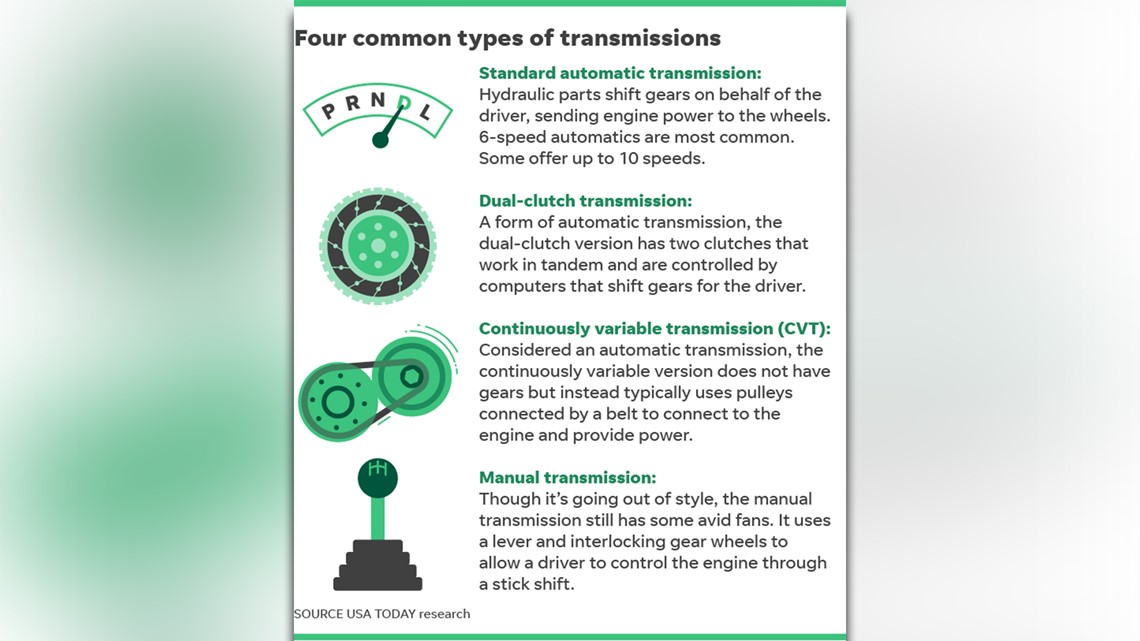The stick shift is choking.
The popularity of cars and trucks with manual transmissions is falling sharply as fewer Americans learn how to drive them and automakers avoid making them.
On top of that, the long-held arguments in favor of driving a stick — that they make cars more fuel efficient and cheaper to buy — aren't always true anymore because automatic transmissions have greatly improved, erasing the practical reasons why some drivers preferred manuals.
So while the stick shift isn’t dead yet, its future is grim.
Once the only kind of transmission available, manuals became an essential part of a car's design, from nondescript, utilitarian sticks and silver wands to elegantly smooth cue balls. These pieces of jewelry were mounted between seats or next to the steering wheel. Now they've become almost irrelevant.
The market for sticks is at a point "where it’s not a necessity or even much of an option,” said Mike Fiske, senior analyst at IHS Markit, who studies automotive powertrain issues.
Look no further than Audi. The luxury automotive brand, part of Volkswagen Group, confirmed that it will no longer offer any manual-transmission vehicles in the U.S. beginning with the 2019 model year.
The final Audi models offered with a stick-shift variant were the 2018 A4 sedan and A5 coupe, Audi spokeswoman Amanda Koons said.
From now on in the U.S., it’s nothing but automatic transmissions for the German brand.
Transmission advancements
After a range of technological advancements in recent years, automatic transmissions now come in various high-tech forms, such as dual-clutch versions that mimic a manual's gear-changing function. Bottom line: They all do the work for you. No more fumbling with the clutch pedal to switch gears.


“Unfortunately,” Koons said in an email, “the customer demand for manuals is quite low.”
Sales of manual transmissions have been falling for decades — but their drop-off has accelerated in recent years.
Stick-shifts represented 6.8 percent of U.S. vehicle sales in 2012, according to IHS Markit. But that figure has tumbled to an estimated 3.5 percent in 2018.
Take the Subaru BRZ. The popular sports car was once sold only with a manual transmission, but sales are now 90 percent automatic, Fiske estimated.
IHS projects that the percentage of cars sold with a manual transmission will fall to 2.6 percent in 2023. And Fiske said recent indicators may require IHS to update its forecast.
“We’re seeing it go even lower,” he said.
But not all hope is lost for stick-shift aficionados. For one thing, they’re still selling in many foreign markets. In fact, Fiske said the 5-speed manual is the most popular transmission in the world.
“They’re low-cost and easy to make,” he said.
And true believers aren’t giving up.
Darryl Hayden, a machine operator from Hampton, Virginia, was committed to buying a manual-transmission car a few years ago but the dealer had only one option on the lot — and it was bare bones. So he had the dealer search high and low for the 2014 Ford Focus he ended up buying.
“That was a very difficult thing” to find, he said. The car "was in South Carolina, and they drove it up to Virginia for me since they’re not making so many now.”
Hayden said he feels more connected to the road with a manual, which he said also helps him stay awake.
“You’ve got more control over the car because you’re shifting your own gears instead of waiting for the car to shift for you,” he said.


While Audi is ending manuals, many major auto brands still offer stick-shift options on certain vehicles. The top five best-selling manuals through July, according to IHS, were the Chevrolet Cruze, Ford Focus, Honda Civic, Hyundai Elantra and Jeep Wrangler Unlimited.
Teaching the next generation
While Hayden loves driving a stick, his ability to do it is simply harder to find than ever.
That’s why Traverse City, Michigan-based classic-car insurer Hagerty is teaching auto engineers how to drive a manual — because many never learned how to drive a stick growing up.
And since 2011, the company has also taught the skill to some 2,500 high school-age kids.
One perk of the lessons: The students learn to shift gears and use a clutch in a retro ride, like a 1969 Chevrolet Camaro SS or a 1965 Ford Mustang convertible.
“Out of all those students, there were only two I think may never get it,” said Tabetha Hammer, a communication specialist with Hagerty.
Automatic future
Perhaps the main reason why the manual transmission is an anachronism is because of the automatic transmission's vast improvements.
“The best manual drivers cannot match the shift speeds of our latest automatics,” said Mark Kielczewski, assistant chief engineer for General Motors’ new 10-speed automatic transmissions. “The transmission detects if the vehicle is going up or down a hill, if the driver is on a curvy road and is driving aggressively or just driving smoothly, it makes the proper adjustments to keep the transmission in the right gear, at the right time, all the time.”
But while the manual transmission may be on its way out, the automatic transmission shouldn't get too comfortable. In fact, its days could be numbered, too.
That's because electric vehicles, which enthusiasts believe could eventually overtake gasoline powered cars, don’t have transmissions at all.
Contributing: Detroit Free Press auto critic Mark Phelan



